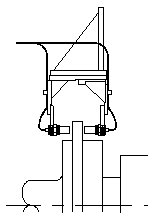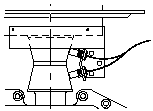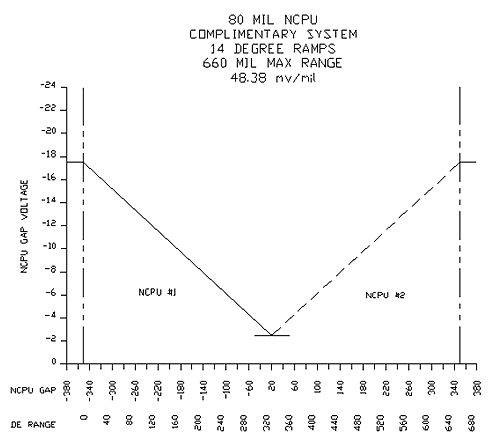Differential Expansion (DE) and/or Rotor
Expansion (RE) are very important measurements usually supplied by the Original Equipment
Manufacture (OEM) as
part of a Turbine Supervisory Instrumentation System (TSI) on large steam turbine
generator applications. Although the application of Differential Expansion and Rotor
Expansion have much in common, it is important to understand the difference between the
two measurements.

Differential Expansion on a turbine is the relative measurement of the
rotor's axial thermal growth with respect to the case.
Rotor Expansion on a turbine is the absolute measurement of the rotor's axial thermal
growth with respect to the turbine's foundation.
A typical large steam turbine power generation unit will have a thick case, on the
order of 12" to 18". Due to the mass of this case, it will expand and contract
at a slower rate than the relatively thin (hollow) rotor. During turbine startup, extra
care must be used to ensure that the case has been properly heated and expanded
sufficiently to prevent contact between the rotor and the case. Several DE or a
combination of DE and RE measurements may be employed on a single large turbine generator.
For many years, Power Generation Utilities and other owners of large steam turbines
have been retrofitting the original OEM supplied TSI systems with modern TSI systems which
are more accurate, and easier and less costly to maintain.
Eddy Probe Transducer Systems have been very successful replacing the older single or
dual coil capacitive and inductance type transducer systems. Eddy Probe Transducer systems
are available with up to 1000 mils (1") of linear range. When properly applied, these
transducers can replace any existing DE or RE transducer system even those with ranges
over several inches.
Existing OEM Applications
In general, modernizing or replacing DE and RE transducers and monitor systems is reserved
for those machines that were originally equipped with these measurements by the OEM.
Usually, the user of the system wants to replace the existing DE or RE system with a
modern system. The new system has exactly the same range and alarm setpoints as the old
system. This insures that the user follows the original OEM operating instructions and
simplifies operator training and understanding.
Large steam turbine rotors were originally manufactured with two (2) types of DE and RE
measurement surfaces:
Perpendicular Collar

Many turbines have one or more integral collars machined on the rotor. These
collars will usually have smoothly machined faces of 2" to 3" and be several
inches thick.
The existing OEM transducer system will usually employ a custom bracket with dual
(complimentary) coils one on each side of the collar.
Rotor Ramp
 Some turbines will have machined conical surfaces or ramps on the turbine shaft at one or more
locations. Ramps increase the operating range of the measurement transducer by the sine of
the ramp angle allowing larger measurements or the use of shorter range transducers. Some turbines will have machined conical surfaces or ramps on the turbine shaft at one or more
locations. Ramps increase the operating range of the measurement transducer by the sine of
the ramp angle allowing larger measurements or the use of shorter range transducers.
The existing OEM transducer system will usually employ a custom bracket with dual
(complimentary) coils mounted perpendicular to the ramp surface.
Ramp angles can usually be determined by referring to the original OEM Turbine Manuals,
or they can be measured if necessary. Common Ramp angles are 7°, 11°, and 14° as examples.
Occasionally a ramp may be machined on a collar. This ramp will usually have a much
larger angle with a smaller viewing surface (ie: 45°).
Retro-fit Applications
In almost all cases, retrofitting the existing DE or RE transducers with Eddy Probe's is
simply a matter of determining the required operating full range with alarm setpoints,
whether its a collar or ramp application, angle of the ramp, and the shaft viewing or
target area.
Whenever the expected range exceeds a single transducer range a complimentary system is
required. A complimentary system utilizes two (2) Eddy Probe transducers viewing the
opposing faces of the collar or ramp. The complimentary system extends the operating full
range of the system. This system operates such that as the collar or ramp moves out of the
operating range of one transducer it moves into the operating range of the second
transducer.
As Eddy Probe systems operate on the proximity theory of operation, they are not
effected by oil or other non- conductive material that may come between the target area
and the transducer. As the Eddy Probe tip radiates a high frequency RF signal roughly in a
45° conical shape from the probe tip the target area must be three (3) times the tip
diameter. Care must be taken to insure that the Eddy Probe transducer is mounted
perpendicular to within a few degrees of the target or viewing area. Excessive mounting
error will change the calibration factor of the installation.
Perpendicular Collar
Perpendicular 90o Collars can be measured by either a single Eddy Probe transducer or by
complimentary transducers mounted on either side of the collar. The size of the collar
face available for the Probe viewing surface and the required measurement range will
determine which method is best suited for the application.
The following operating ranges are available. The operating full range for single
transducer applications viewing a perpendicular collar is the same as the transducer's
linear range.
|
Single |
Complimentary |
| CMSS65/68 |
90 mils |
180 mils |
| CMSS62 |
240 mils |
480 mils |
| CMCP1000 |
1000 mils |
2000 mils |
Installation of the required Eddy Probe transducer(s) can be made by either modifying
the existing DE or RE bracket, or by fabricating a new bracket.
Rotor Ramp
A Rotor Ramp installation can also be measured using either a single Eddy Probe transducer
or by complimentary transducers configuration. The size of the Probe viewing surface and
measurement range required will determine which method best suites the application.
The operation range of the transducer is calculated by dividing its published linear
range by the sine of angle of the ramp. Double the single transducer range for
complimentary transducers.
For example, the following operating ranges are available using the following extended
range Eddy Probe systems viewing a 14° Ramp.
|
Single |
Complimentary |
| CMSS65/68 |
372 mils |
744 mils |
| CMSS62 |
992 mils |
1984 mils |
For example, for a 500 mil measurement range with a 14° ramp, the complimentary P/N
CMSS68 system should be used. This will maximize resolution of the monitoring system, and
yield the most economical installation.
Installation of the required Eddy Probe transducer(s) can be made by either modifying
the existing DE or RE bracket, or by fabricating a new bracket.
Installation
DE and RE Eddy Probe systems operate on the proximity theory. A Eddy Probe system consists
of a matched component system: a pickup, an extension cable, and a signal sensor.
The signal sensor generates a high frequency
oscillating RF signal that is sent through the extension cable to the pickup tip. The
pickup tip, having a wound coil of fine wire, radiates a electromagnetic field. As the
radiated field is bisected by the rotor surface, eddy currents are created on the rotor
surface. As the rotor surface moves closer to the pickup tip, a greater amount of eddy
currents are created proportional to the gap between the surface and the pickup tip. The
signal sensor contains a demodulator which measures the increase in eddy currents, and
generates an equivalent DC voltage proportional to the gap.
Extra care must be exercised
to ensure that the pickup axis is perpendicular to the viewed surface. An error of 1° can cause a significant error in the measurement.
Calibration
In all cases, it is extremely important to complete a calibration curve or graph prior to
installation. This graph allows the engineer to document and graphically visualize how the
required mechanical range and alarm setpoints fit the Probe's system's operating range.
First, prepare an Eddy Probe system calibration curve using the supplied calibration
data, or using actual empirical calibration data derived in the field. Then overlay the
required full scale range and alarm setpoints for the machine on the calibration curve.
The two curves should be centered so that there is an equal amount of unused linear range
at each end of the Probe curve.
With this graph completed, gapping the Eddy Probe transducers is simply a matter of
knowing the mechanical position of the rotor, finding the matching Probe DC Gap on the
graph and gapping the Eddy Probe transducers appropriately.
Pickup Calibration - Single DE with Collar
Once the required DE range has been established, the operating range of the pickup must
not be exceeded by the DE measurement. The pickups should be calibrated, or adjusted, when
the turbine is in a known thermal condition. This condition is almost always when the
turbine is in a cold state. The OEM documentation may list the cold setpoint as the
"Green Mark" condition with corresponding DE measurements that the
instrumentation system should indicate.
Next, the direction of thermal growth must be determined. The indications may be termed
"rotor long" and "rotor short". The OEM may list the two extreme alarm
setpoints as "Red Mark".
For example, consider a turbine with the thrust bearing at the front standard, the DE
collar located between the LP turbine and the generator, and the single DE pickup located
on the governor side of the collar. The "rotor long" indication will be when the
relative gap measurement between the collar and the pickup has increased. The "rotor
"short" indication will be when the gap has decreased.
The pickup should be chosen so that the linear range of the pickup exceeds the expected
DE range including the alarm setpoints. The cold setpoint for the pickup adjustment should
allow the center of the DE range to correspond with the center of the pickup's operating
range. A simple calculation will provide the required pickup gap for the cold setpoint.
Pickup Calibration - Single DE with Ramp
The same requirements as listed in the section above apply for a single DE pickup system
with a ramp target.
Additional requirements are that the ramp angle must be included in the transducer
calibration curve with the gap and alarm setpoint calculations.If the ramp surface is
small, the pickup diameter sizing must be a consideration. Also, the pickup orientation
with respect to the ramp must be considered to insure that the ramp will not
"grow" out from under the pickup at either alarm extreme.
Consider the above example, but the target is a collar with a 45° ramp machined on the
outer edge. The DE pickup is located on the governor side of the collar. When the turbine
is in the cold state, the pickup to ramp orientation should have the pickup located near
the bottom of the ramp. As the indication approaches "rotor long", the pickup
will be oriented near the top of the ramp.
Pickup gap voltages (VDC) would be calculated to include the 14 ramp angle as follows:
Cold Gap Volts = Cold Gap x sin(14 )
Rotor Long Volts = Long Gap x sin(14 )
Rotor Short Volts = Short Gap x sin(14 )
Pickup Calibration - Dual DE with Collar
Dual DE pickup systems viewing a collar will have two separate Probe systems that view
either side of the DE collar. This application is a complimentary system where the collar
should grow out of the range of one pickup and into the range of the other pickup.
One pickup will be installed on the governor side of the collar and the other installed
on the generator side of the collar. Generally the pickups will be installed so that when
the collar is centered in its operating range, both pickups should be indicating the same
gap voltage reading.
Cold pickup adjustment involves determining the equivalent gap voltage for the pickup
on the governor side of the collar. This pickup may be gapped electrically.
The other pickup may be out of its operating range when the turbine is in the cold
condition. This means the pickup on the generator side of the collar will have to be
gapped mechanically.
Mechanically gapping the generator pickup involves figuring the difference between the
cold gap of the governor side pickup and the equivalent gap of the governor side pickup
when the collar is centered, and adding this value to the equivalent gap of the generator
side pickup when the collar is centered. This calculation will result in an equivalent
mechanical gap at which the generator side pickup is to be gapped.
Pickup Calibration - Dual DE with ramp

Dual DE pickup systems follow the same requirements discussed above for collar
applications, but the gap voltage or mechanical gap values will incorporate the ramp angle. Certain turbines may have the ramps
machined so that the pickups, when installed, are facing away from each other. Other
turbines will have the ramps machined so that the pickups face towards each other.
Regardless of the orientation, the pickup calibration procedure is the same.
For this application, one the governor side pickup will be calibrated (adjusted or
gapped) electrically, while the other will be calibrated mechanically while the turbine is
in the cold condition.
This application will have each pickup indicating the same gap voltage when the both
ramps are centered on the pickups. The governor side pickup cold setpoint is calculated
for a 11 ramp as follows:
Cold Gap Volts = Cold Gap x sin(11 )
Calculating the required mechanical gap for the generator pickup involves figuring the
difference between the cold gap of the governor side pickup and the equivalent gap of the
governor side pickup when the ramps are centered, and adding this value to the equivalent
gap of the generator side pickup when the ramps are centered. This calculation will result
in an equivalent mechanical gap at which the generator side pickup is to be gapped.
DE Installation Checklist
- Mounting Type, Collar Ramp
- Ramp Angle
- No. of Pickups, Single Dual
- Pickup Linear Range
- DE Cold Setpoint
- DE Rotor Long Setpoint
- DE Rotor Short Setpoint
- Pickup Orientation, Gov Side Gen Side
- Target Sizing
- Pickup Bracket(s) Documented
- Pickup Calibration Documented
- Pickup Cold Gap Documented
|

